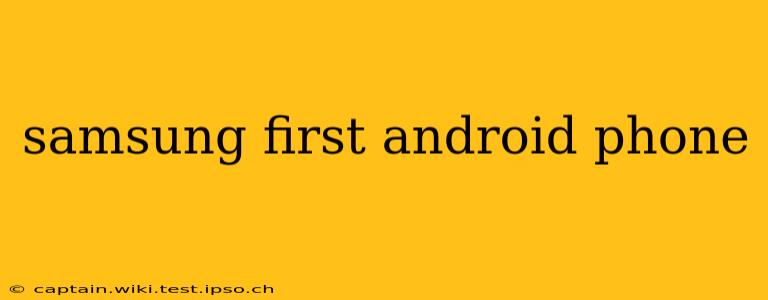Samsung's journey in the Android world is a long and successful one, but it all started somewhere. Before the Galaxy S series dominated the market, before foldable phones became a reality, there was the Samsung i7500. This unassuming device marked Samsung's foray into the burgeoning Android ecosystem, laying the groundwork for the mobile giant we know today. This post will delve into the history of Samsung's first Android phone, exploring its specifications, impact, and answering some frequently asked questions.
What was Samsung's first Android phone?
Samsung's first Android phone was the i7500, also known as the Samsung Galaxy i7500. Released in 2009, it wasn't the sleek, powerful device we associate with Samsung today. However, its significance lies in its pioneering role. It wasn't just a phone; it was a stepping stone, a testament to Samsung's early adoption and strategic investment in Android.
What were the specifications of the Samsung i7500?
Compared to modern smartphones, the i7500's specifications might seem modest. It featured:
- Android 1.5 Cupcake: This was the operating system of the time, representing the early days of Android's development.
- A 3.2-inch touchscreen display: Relatively small by today's standards.
- A 5-megapixel camera: A decent camera for its time, although lacking many of the features found in modern cameras.
- 8GB of internal storage: Limited storage, making reliance on microSD cards necessary.
- A 1GHz processor: A modest processor by today's standards but cutting-edge in its time.
When did Samsung release its first Android phone?
The Samsung i7500 was released in late 2009, marking a pivotal moment in both Samsung's and Android's history. The timing was crucial, as it allowed Samsung to establish a presence in the rapidly growing Android market.
What is the significance of Samsung's first Android phone?
The Samsung i7500’s significance transcends its technical specifications. It was a strategic move that showcased Samsung's foresight and commitment to the Android platform. This early adoption paved the way for Samsung's eventual dominance in the Android smartphone market. It allowed the company to gain valuable experience in developing and marketing Android devices, knowledge that proved instrumental in the later success of the Galaxy S series and beyond.
Did Samsung's first Android phone have any notable features?
While lacking the advanced features of modern smartphones, the i7500 did boast some notable features for its time, including its relatively large touchscreen and a decent camera. Its significance lay primarily in being one of the first Android phones from a major manufacturer, paving the way for the proliferation of Android devices.
How did Samsung's first Android phone compare to other early Android phones?
The i7500 held its own among the early Android phones from other manufacturers. While some might have had slightly better specifications in certain areas, the i7500's release from a well-established electronics company like Samsung gave it an edge in terms of brand recognition and marketing. This played a crucial role in building consumer trust and confidence in Android as a viable platform.
Conclusion
The Samsung i7500 may seem rudimentary by today’s standards, but it holds a significant place in the history of Android smartphones. It represents a bold move by Samsung, a commitment to the Android platform that ultimately transformed the mobile landscape. It’s a reminder of how far the technology has come and the pivotal role Samsung played in shaping the mobile world as we know it. The legacy of the i7500 lives on, not just in the technological advancements it spurred, but also in the enduring success of Samsung's Android smartphone empire.
